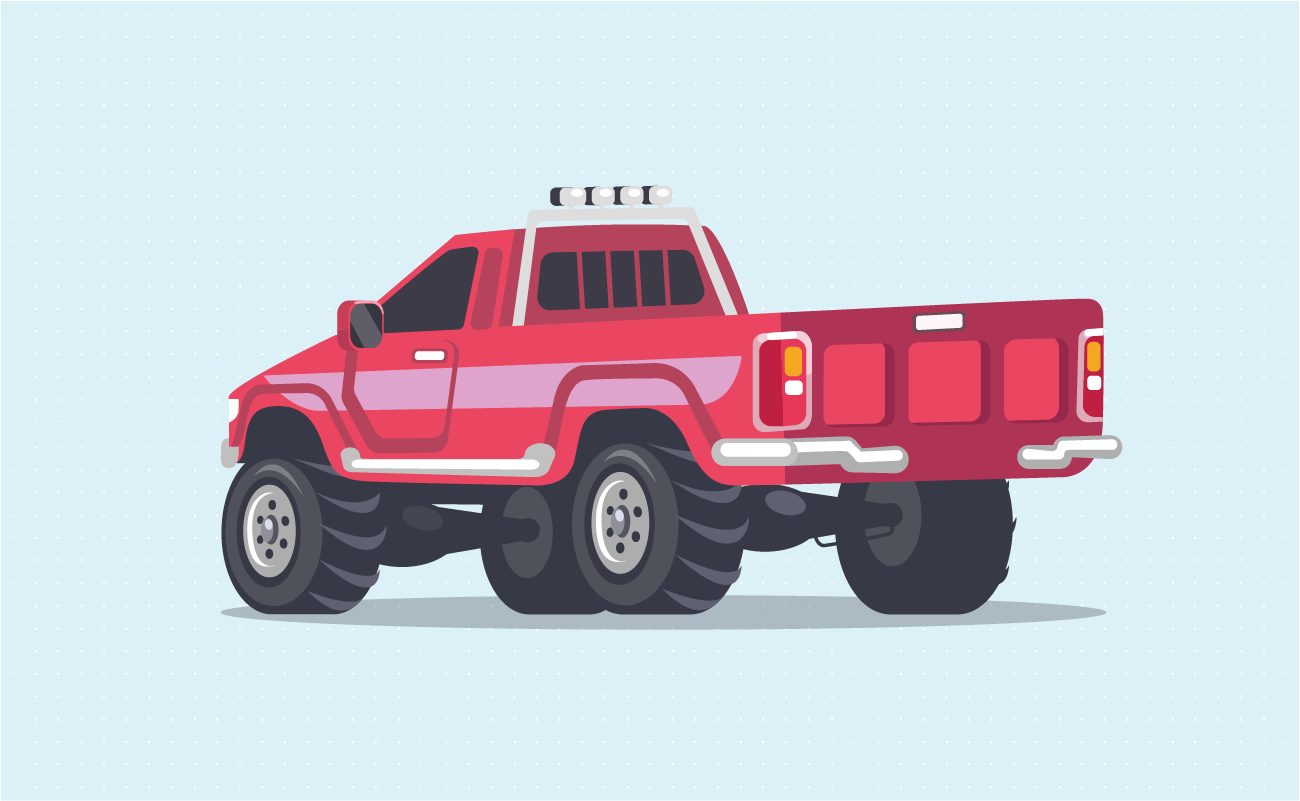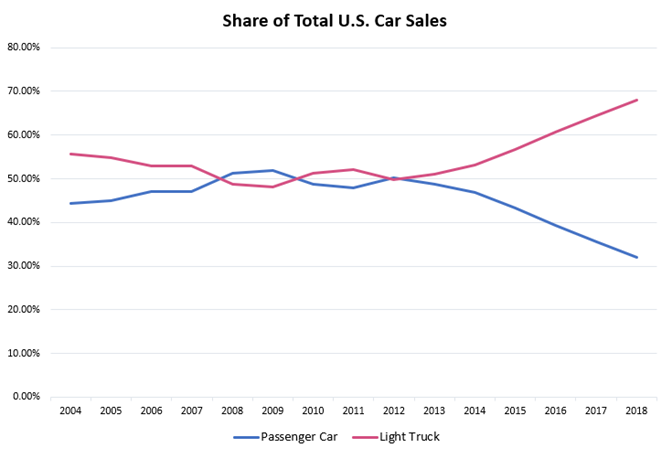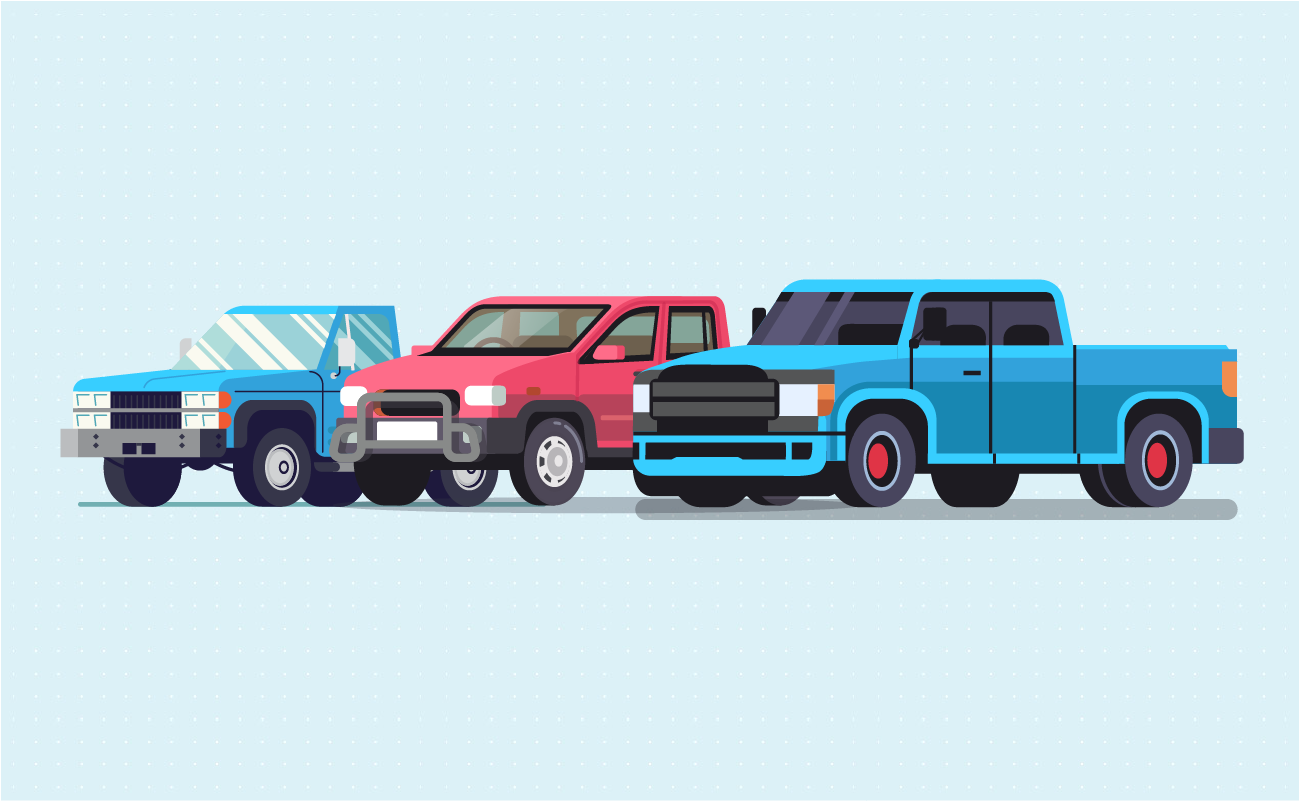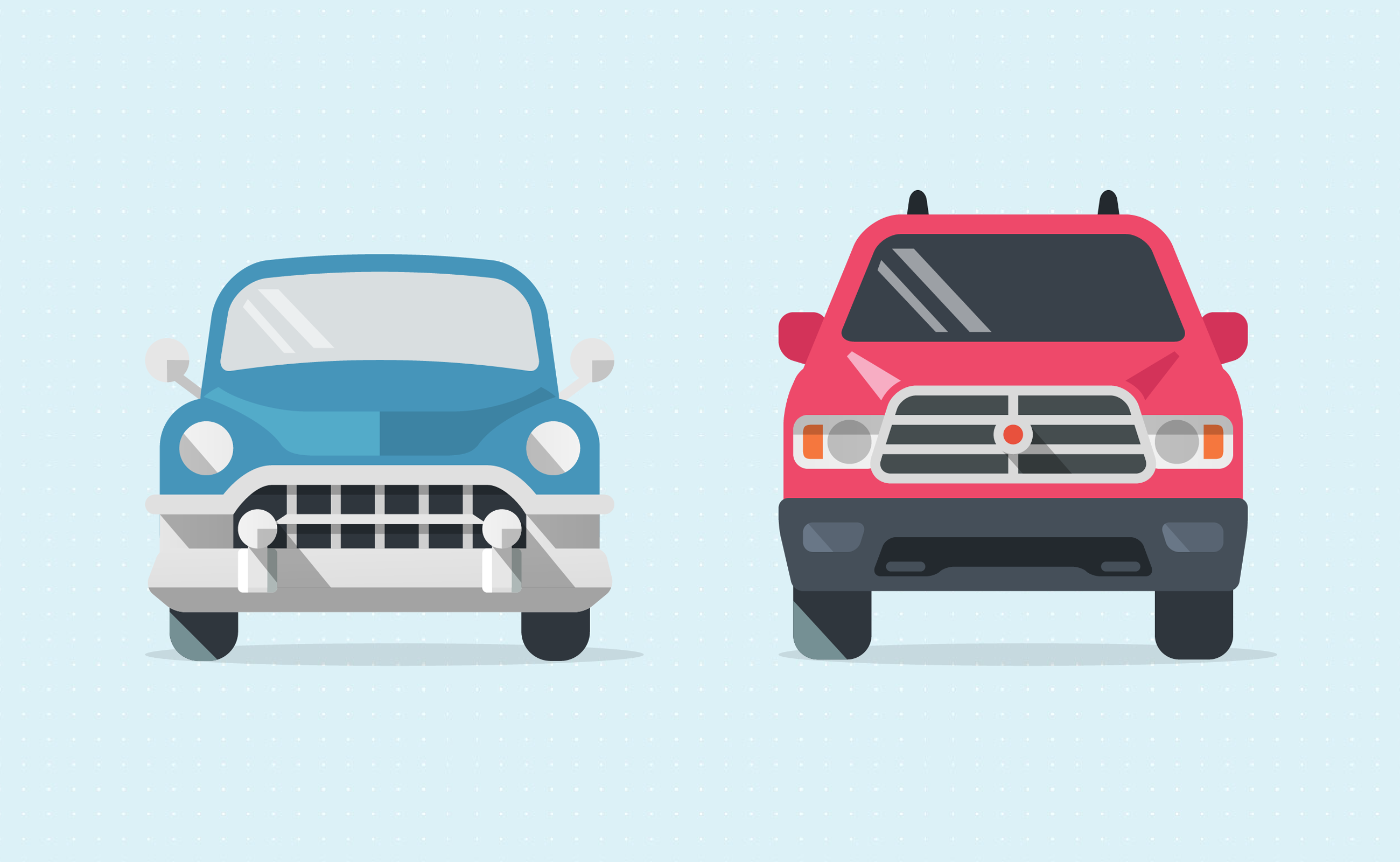Auto Loans
Affordability
Loan Payment Options
Biweekly Payments
Compare Rate & Term
Rebate vs Low Interest
Home Equity Loans
Lease or Buy
 Truck Payment Calculator
Truck Payment CalculatorUse this calculator to quickly estimate the monthly payments on a truck loan. Enter the amount borrowed, any application fees, the loan term & interest rate charged on the loan. This calculator defaults to monthly payments though you can change to using an alternate payment frequency. There are also options to add sales tax, trad ins and rebates to your calculation. The affordability calculator in the second tab allows you to estimate an affordable vehicle price based on your current savings and monthly budget.
Authored by Jose Abuyuan on March 12, 2020
Pickup trucks are one of America's most popular vehicles. According to Forbes, trucks account for around 15 percent of vehicle purchases, with consumers buying about a million cars every year. Today, pickup trucks and SUVs take up over 70 percent of U.S. auto sales.
Trucks are commonly used by contractors for hauling and other equipment needs. But apart from performing heavy work, the half-ton light-duty truck has inched its way as a common reliable family vehicle.
In this feature, will talk about how trucks and SUVs have overtaken the automotive industry. We'll compare average truck prices with cars, as well as different types of trucks and best-selling models. Then, we'll discuss when consumers should choose new or used trucks, and the best times to purchase them. Finally, the guide will break down the total ownership cost of having a truck versus a small car.

Sedans or compact cars were once the quintessential American vehicle. Back in the day, the humble family sedan was a staple part of American culture. It was the major transporter of suburban commutes and long road trips.
However, shifting consumer needs along with changes in the automotive industry bolstered demand for pickup trucks and sports utility vehicles (SUV). The New York Times states that 2009 was the last time cars outsold light trucks and SUVs in the U.S. Since then, more consumers tend to purchase pickup trucks and SUVs.
In 2010, pickup trucks made up around 14 percent of overall vehicle sales in the U.S. By 2017, pickup truck sales rose to around 16 percent, according to the Wall Street Journal (WSJ). The same report also notes the vast increase in SUV sales, from 30 percent in 2010 to 42 percent in 2017.
By 2019, pickup trucks and SUVs took over 70 percent of the automotive market, with 5.9 million sales through June in contrast with 2.5 million car sales. Sales of midsize sedans decreased from 3 million in 2012 to 1.9 million in 2019. Back in 2012, 1 in every 5 cars sold was a midsize sedan. But in 2019, it's hardly 1 in 10 vehicles.
Historically, cars took up most of the market share in the 90s. Based on Wards Intelligence data, passenger cars accounted for 67 to 51 percent of vehicle sales throughout 1990 to 1999. But towards the 2000s, light trucks started to compete for a larger share of the market. In 2004, light trucks took over 55.64 percent of vehicle sales, while passenger cars obtained 43 percent of overall car sales.
To see how vehicle sales shift from cars to light trucks between 2004 to 2018, refer to the graph below.

*Includes SUVs, pickup trucks, and vans. Note: 2018 sales through June, data from Wards Intelligence
| Year | Passenger Car | Light Truck |
|---|---|---|
| 2004 | 44.36% | 55.64% |
| 2005 | 45.02% | 54.80% |
| 2006 | 47.03% | 52.97% |
| 2007 | 47% | 53% |
| 2008 | 51.30% | 48.70% |
| 2009 | 51.93% | 48.07% |
| 2010 | 48.77% | 51.23% |
| 2011 | 47.82% | 52.18% |
| 2012 | 50.20% | 49.80% |
| 2013 | 48.85% | 51.15% |
| 2014 | 46.85% | 53.15% |
| 2015 | 43.21% | 56.79% |
| 2016 | 39.35% | 60.65% |
| 2017 | 35.48% | 64.52% |
| 2018 | 32.04% | 67.96% |
Reporter Michael Colias of WSJ notes that the shift from cars to light trucks and SUVs may be due to marketing, the vehicle's evolving design, and its overall practicality. Colias states:
“Over the past decade, car makers have figured out how to offer the best attributes of an SUV—more cargo room, higher seating with better visibility and improved bad-weather handling—in smaller, carlike packages that use far less fuel than their predecessors. Many of the small models add just $20 or $30 more a month to a traditional car payment. That also helps auto makers, which earn higher profits on these vehicles.”
New pickup trucks provide a smoother ride and comfortable features compared to standard sedans. Many consumers also prefer light trucks and SUVs for safety reasons. Larger and heavier vehicles are safer because they can protect better in a crash, states the Insurance Institute for Highway Safety. WSJ reports that many consumers start driving SUVs at a young age because their parents insist on SUVs for safety.
General Motors has begun removing cars that no longer generate profits, including the plug-in hybrid Chevrolet Volt. Even luxury car manufacturers which once overlooked SUVs now offer their own brand of SUVs. These companies include Lamborghini, Porsche, Maserati, and Rolls-Royce. With the huge change in the industry, even Ferrari and Aston Martin are slated to follow suit.

Pickup trucks these days are more expensive than compact cars. This is because trucks are larger, more powerful, and tend to have greater heavy-duty components than smaller vehicles. It's a family car that can fit up to 6 people in full-sized cabins.
Through the decades, the plain pickup truck evolved to offer classy and comfortable interiors, along with latest tech features which compact cars also provide. Though they are one of the most expensive vehicles to own, light trucks operate by a good margin.
According to car guide resource Kelly Blue Book, below are the average prices for cars versus pickup trucks and SUVs under the 2019-2020 New Car Buyer's Guide released in December 2019.
| Vehicle Type | Average Price |
|---|---|
| Small cars | $20,000 |
| Midsize cars | $25,000 |
| Pickup trucks | $41,000 |
| Small SUVs | $26,000 |
| Midsize SUVs | $33,000 |
Notice that the average pickup truck price is the highest at $41,000, followed by midsized SUVs at $33,000 and small SUVs at $26,000. Small cars, on the other hand, are priced the lowest at $20,000, followed by midsized cars at $25,000.
To break down the average transaction prices with a specific type of vehicle, let's refer to related data below. Valuation analyst Tim Fleming of Kelly Blue Book reported that the average transaction price for a light vehicle in the U.S. reached $37,876 in February 2020. This is a 2.6 percent year-over-year increase from 2019. For the average transaction price per vehicle type, see the table below.
Cars, Pickup Trucks, and SUV/Crossovers
| Vehicle Type | February 2020 | February 2019 | Percent Change |
|---|---|---|---|
| Compact car | $21,054 | $20,443 | 3.0% |
| Midsize car | $26,251 | $25,899 | 1.4% |
| Full-size car | $35,440 | $35,307 | 0.4% |
| Midsize Pickup Truck | $35,222 | $33,726 | 4.4% |
| Full-size Pickup Truck | $49,672 | $49,951 | -0.6% |
| Compact SUV/Crossover | $29,997 | $29,293 | 2.4% |
| Midsize SUV/Crossover | $39,921 | $38,614 | 3.4% |
| Full-size SUV/Crossover | $62,869 | $63,025 | -0.2% |
| Industry average | $37,876 | $36,901 | 2.6% |
*Kelley Blue Book average transaction prices do not include applied consumer incentives
Data from PR Newswire
The table above shows that compact cars remain the lowest in average price at $21,054 in February 2020. Full-size SUV/Crossovers are the highest priced at $62,869, followed by a full-size pickup truck at $49,672 in February 2020.
Fleming notes that many major vehicle manufacturers raised prices by over 4 percent, shifting capital in favor of SUVs. However, full-size trucks seem to show some signs of tapering. After prices rose by 3 percent in 2018 and 4 percent in 2019, truck prices have mostly been flat through February 2020.
Based on the table above, the price of full-size pickup trucks decreased by -0.6 percent from $49,951 in February 2019 to $49,672 in February 2020. Meanwhile, there's an increase in SUV/Crossover prices, with a 3.4 percent average price boost for mid-size SUV/Crossovers compared to the previous year. Fleming reported:
“With the GM and Ram trucks in their second year of production and Ford about to sell-down the current F-150 for its upcoming redesign, this year may be a good time to find a deal on a new truck.”

Truck classification is based on gross vehicle weight rating (GVWR). This helps manufacturers label trucks according to government guidelines. GVWR regulates safety and specifies the minimum truck weight including fuel, passengers, cargo, as well as the trailer tongue. It also indicates what the vehicle is built to endure.
Truck class ranges from Class 1 to Class 9, with Class 1 to 3 designated for non-commercial consumer vehicles such as pickup trucks, SUVs, minivans, and cargo vans. Succeeding classes from 4 to 9 include non-commercial medium trucks, but some are still used for contracting purposes. They also include heavy-duty trucks and units with longer, heavier loads used for commercial hauling.
Pickup trucks come in a wide gamut of permutations. According to Consumer Reports, depending on your needs and preference, you have the option to choose between a regular cab, extended cab, or a crew cab. You can also get a long bed truck or a short one, as well as two-door or four-door options. Standard, automatic, and four-wheel drive transmissions are also available. Pickup truck engines start from 4-cylinder engines, to V6, V8 and big diesel engines.
But aside from many features, pickup trucks are classified according to their size. Consumers can choose between compact and midsize pickup trucks, full-size pickup trucks, and heavy-duty trucks.

Make a realistic assessment of your needs before buying a large truck. It's easy to go overboard on the load, so just choose based on practical function. Even if you go on frequent family trips, you might not need that much storage space. Finally, if you don't haul heavy load often, it's better to rent a truck than put up with a large vehicle that does not suit your needs.
If you prefer a truck for camping and long drives, a compact or midsized truck already does the job. For people who plan to haul heavy equipment or debris, a lighter-duty full-sized truck is better suited for the job.

As the name suggests, this group includes smaller truck models which come with 4-cylinder or V6 engines. Edmunds states that compact trucks today aren't as small as before. Unlike the ‘mini-trucks' of the 80s and 90s, many new models are midsize trucks with almost full-size proportions.
U.S. News states as of March 2020, the 2019 Honda Ridgeline is the best-selling compact and midsize pickup truck, followed by the 2020 Ford Ranger and 2020 GMC Canyon in second place. On the third spot is the 2020 Chevrolet Colorado. Other compact and midsize pickup trucks include Toyota Tacoma, Ford Ranger, Jeep Gladiator, and Nissan Frontier.

This type of trucks is larger and higher off the ground than its compact and midsized counterpart. If you've heard of 1500-series vehicles, the term actually refers to full-size pickup trucks. Full-size pickup trucks are popular family cars that fit up to 6 passengers.
If you're headed out with your family for vacation, full-size trucks have more than enough storage for luggage, coolers, tents, fishing rods, bicycles, surfboards, and any other item you need to bring on a trip. Full-size pickups are also well-suited for heavy hauling and light contracting jobs.
Examples of full-size pickup trucks are Ford F-series trucks, Chevrolet Silverado 1500, Ram pick-up, GMC Sierra and Toyota Tundra.

These types of trucks are larger and referred to with 2500 or 3500 in their label. Heavy-duty trucks are specifically designed to move weighty loads. They are also built to haul large fifth-wheel travel trailers.
If you need a truck for commercial cargo hauling and other related purposes, this is the truck for you. In this respect, purchasing a heavy-duty truck for mere personal use does not maximize the vehicle's function. It would be better to have one if you really need it. Examples of heavy-duty trucks include the GMC Sierra 2500HD, Nissan Titan XD, and the Ram Power Wagon Crew Cab.
According to TrueCar.com, the 2019 Super Ford Duty F-450 is the top heavy-duty truck of 2019. On the second spot is the 2019 Ram 3500, followed by the 2020 Chevrolet Silverado 2500HD.

When looking for a truck, you've probably wondered if new or used better. Both have their own advantages, but there are instances when buying a new truck or getting a used unit may be more advantageous in the long run.
A brand-new truck provides you with the latest features, specifically the newest engineering improvements and safety components. New vehicles also have minimal maintenance issues compared to used ones. This means new trucks are safer and more functionally efficient than old models. Consumers are also drawn to new trucks because of their lower financing rates in contrast to used units.
On the downside, new trucks have a rapid depreciation rate. According to Consumer Reports, brand-new trucks can lose half of their original value within the first 2 or 3 years of use. The depreciation landscape can vary from year to year. This relies on many aspects, such as fuel prices, the coming of new models, and other economic factors. Which brings us to another drawback: Paying a small down payment may put you upside down on your auto loan. In short, it's possible you may end up owing more than your truck's actual value if you have a large balance.

Buying a brand-new truck is beneficial if you're keen on obtaining a unit without wear-and-tear or prior damage. If you want a truck for long-term use, a new one is well worth it. Trucks commonly perform heavy hauling, which means used models sustain considerable wear-and-tear beyond normal use. To be extra safe, go for a brand-new truck.
Meanwhile, used trucks are not as costly as new ones. Buying a pre-owned unit is advantageous especially if you have a tight budget. Choosing a second-hand unit helps you avoid the high depreciation cost during the first few years of your auto loan. If you wait 2 or 3 years before buying a particular model, you'll realize how much money gets shaved off the original price.
Moreover, the used truck market is three times larger than the new truck market. There's plenty of variety and you will likely find a pre-owned model that suits your needs. And if you're worried about reliability, modern pickup trucks can run for 200,000 miles of more with good routine maintenance. Just make sure to find a pre-owned truck in good condition.
On the drawbacks, sometimes used vehicles have mechanical issues that go undisclosed, which could cost you a large sum on repairs. Apart from breaking your budget and the lack or reliability, vehicle issues can compromise your safety. To offset this, research for models with high reliability scores. Make a thorough background check and ask how the vehicle was used and maintained. You specifically want to avoid trucks that show signs of severe duty such as heavy towing and off-road use.

In buying a used truck, look for a model that's only a few years old. This helps ensure the unit has more of its useful life in tact. And since used trucks sustain more than the average vehicle, make sure to have a professional mechanic conduct thorough inspection. If it has complicated mechanical problems, move on to safer, more reliable prospects.

When it comes to scoring a favorable deal, the best time to purchase a truck is when dealerships are eager to meet their sales goals. It also matters that you go to a dealership that is not crowded. This gets you undivided personal attention from the sales agent, helping you negotiate a better offer.
So when should you buy a truck? Time your purchase sometime during the start of the week, such as between Monday to Wednesday so the dealership doesn't have many clients. Next, visit during the end of the month so you can get more advantageous offers.
Sales agents have monthly, quarterly, and yearly sales quotas. They tend to be more accommodating if giving you a good deal will help them reach their sales target. Sales deadlines don't always fall on the 30th, so go a few days earlier around the 26th or 28th.

The best time of the year to purchase a truck is during holidays and the months of October, November, and December. Take advantage of holiday sales like Black Friday, Christmas sales, and New Year's Eve sales to obtain a good deal.
You can also purchase the current year's model once next year's model is out. You're likely to get a favorable offer since the dealership needs to get rid of old units to make room for new ones.
When not to buy a vehicle. Edmunds.com states that the least discounted months for car sales is during January to April. If you have the luxury of time, wait a bit more before purchasing a truck.
Vehicles incur many expenses. On top of paying down monthly interest and balance on a loan, you have to factor in the following costs and other related expenses:
In 2018, the average vehicle cost $9,761 per year to own and use. This data is based on the U.S. Department of Labor's Bureau of Labor and Statistics Consumer Expenditures for 2018. If we break down the vehicle expenses, the data states that the average consumer spends $3,975 a year for buying the unit and another $2,109 for fuel and motor oil costs. On top of this, a consumer spends around $3,677 for other car related costs. This can include everything from maintenance, parking, taxes, insurance, and other ancillary fees.
What about the average cost for different types of vehicles? The American Automobile Association's (AAA) offers a more detailed breakdown of vehicle ownership cost per unit type. AAA has been compiling data on the expenses of driving since 1950 with Your Driving Costs survey. This summarizes the amount of gasoline, maintenance, insurance, license and registration, loan finance charges, and depreciation costs for many types of vehicles. Expenses in each vehicle category are based on average costs for the 5 top-selling vehicles of the year selected by AAA.
The table below details the annual cost per vehicle type in 2019, based on 15,000 miles driven annually:
| Vehicle Type | Annual Cost |
|---|---|
| Small Sedan | $7,114 |
| Hybrid | $7,736 |
| Electric | $8,320 |
| Small SUV | $8,394 |
| Medium Sedan | $8,643 |
| Medium SUV | $10,265 |
| Large Sedan | $10,403 |
| Pickup truck | $10,839 |
Data from The American Automobile Association
The annual cost of owning a medium sedan is $8,643, while the annual cost of owning a pickup truck is $10,839. That's $2,196 in savings if you choose to buy the medium sedan.
When we compare the ownership cost of a medium sedan and pickup truck based on the table above, the price difference shows a smaller car costs less than owning a larger vehicle. And since the pickup truck is the largest vehicle in the table, it incurs the highest ownership cost among other vehicle types per year.
For a more specific example, let's break down the cost of owning and operating a sedan and pickup truck. The table below compares the cost of owning a 2018 Ford Focus Sedan and a 2018 GMC Sierra 1500 over a 5-year loan term.
| Vehicle Cost | 2018 Ford Focus Sedan | 2018 GMC Sierra 1500 |
|---|---|---|
| Depreciation | $9,371 | $11,755 |
| Fuel | $7,030 | $10,347 |
| Insurance | $4,059 | $3,818 |
| Maintenance | $3,925 | $4,096 |
| Financing (Interest) | $2,453 | $4,512 |
| Repairs | $745 | $880 |
| Taxes and Fees | $686 | $1,070 |
| Total / True cost to own | $28,269 | $36,478 |
| Total cash price | $15,690 | $28,865 |
*Numbers are based on a 5-year estimate with 15,000 miles driver per year
Figures from Edmunds.com
In the above example, the 2018 Ford Focus has an estimated price of $15,690. But when you factor in other expenses such as depreciation, fuel, maintenance, and other expenses, the projected true cost is around $28,269. Meanwhile, the 2018 GMC Sierra 1500 has an estimate price of $28,865. However, when we include other vehicle-related expenses, the estimated true cost is around $36,478.
Depreciation accounts for the highest cost for every vehicle. Cars lose 20 to 30 percent of their value by the first year of use. The second largest cost is fuel. Take note that trucks rack up higher expenses because they need more fuel compared to lighter and smaller vehicles. The next highest expenses are insurance and maintenance. Insurance expenses are based on the average annual insurance premium as defined by major insurers. Maintenance, on the other hand, refers to charges for scheduled or unscheduled factory services.

If you're worried about the cost of fuel, try looking for trucks with higher fuel efficiency rating. And though trucks are generally more costly to own, you get the most value for your purchase if you maximize its use.

Deciding to buy a truck is a major financial investment. While it's easy to get caught up with fancy features and sleek-looking exteriors, don't forget why you're buying it in the first place. Always prioritize function first.
Perhaps you're buying a truck to transport construction supplies for your business. Or maybe you want a large and reliable family car to safely drive your kids. Keep your objectives in mind so you won't fall trap to unnecessary upselling schemes. At the end of the day, you want to make the most out of your purchase.
Deciding whether to buy or lease a car? Read our guide and use our auto lease or buy calculator.
Jose Abuyuan is a web content writer, fictionist, and digital artist hailing from Las Piñas City. He is a graduate of Communication and Media Studies at San Beda College Alabang, who took his internship in the weekly news magazine the Philippines Graphic. He has authored works professionally for over a decade.